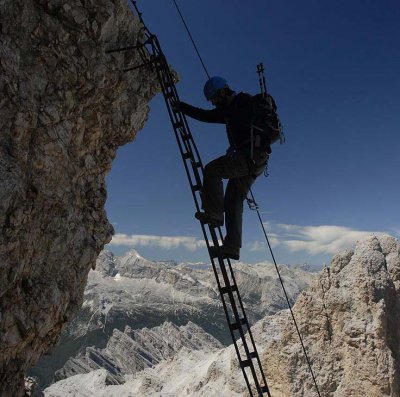Difficulty
To help you understand how we rate treks, we have written down the difficulty characteristics of treks and ferrata. Please consider this also as a guide for rating your own treks on this website. Do not take the characteristics literally. Overlaps between points are necessary.
For example, on a hike up a mountain Schafberg we are at an altitude of 1 782 m above sea level (which corresponds to difficulty 3), but it is rated as difficulty 1 because only 460 m have been climbed.
5 levels of hikes difficulty
1. Easy hike
| Condition |
Families with small children (in a carrier), active pensioners. |
| Movement at altitude |
500 - 1 000 m n. m. |
| Meters climbed |
0 - 500 m |
| Characteristics |
Forest roads, footpaths, paved roads. |
| Equipment |
Low sturdy shoes are sufficient, they do not need to be ankle boots. No other equipment requirements. |
2. Easy hike with elevation gain
| Condition |
Families with school-age children, sports pensioners. |
| Movement at altitude |
1 000 - 1 500 m n. m. |
| Meters climbed |
500 - 1 000 m |
| Characteristics |
Rocky mountain roads, steeper profiles, short sections secured with chains. |
| Equipment |
In most cases, we recommend ankle boots. For less confident hikers, trekking poles are suitable. |
3. Intermediate hike
| Condition |
Hobby athletes, pensioners in top condition, teenagers in good shape. |
| Movement at altitude |
1 500 - 3 000 m n. m. |
| Meters climbed |
1 000 - 1 500 m n. m. |
| Characteristics |
Possibility of exposed sections with chains (for the experienced alpine hiker without the need for a belay). Movement on snow, the need to walk confidently in rocky terrain. |
| Equipment |
Ankle boots a must. Ferrata seat and helmet required for routes with ferrata. For this difficulty it is advisable to have layered clothing with a waterproof outer layer. |
4. Hard hike
| Condition |
Very good condition required, not suitable for pensioners or children under 18. |
| Movement at altitude |
3 000 - 4 500 m n. m. |
| Meters climbed |
1 500 - 2 000 m |
| Characteristics |
Multiple day treks, frequent exposed sections, glacier movement, all types of mountain terrain including glacier movement. |
| Equipment |
Ankle boots a must. Ferrata seat and helmet required for routes with ferrata. It is advisable to have layered clothing with a waterproof outer layer. Trekking poles will help considerably on most routes. Appropriate equipment is necessary when moving on a glacier - crampons, rope, helmet, ice axe.. |
5. Extremely difficult hike
| Condition |
Active sports people in perfect health and psychological condition. |
| Movement at altitude |
4 500 m n. m. and more |
| Meters climbed |
over 2 000 m |
| Characteristics |
Multiple day expedition treks, need for special equipment, frequent movement in exposed areas, all types of mountain terrain including glacier movement. |
| Equipment |
Ankle boots a must. Ferrata seat and helmet required for routes with ferrata. It is advisable to have layered clothing with a waterproof outer layer. Trekking poles will help considerably on most routes. Appropriate equipment is necessary when moving on a glacier - crampons, rope, helmet, ice axe..
|
5 levels of ferrata difficulty according to Kurt Schall
A - easy ferrata
| Condition |
Experienced alpine hiker without vertigo with the confidence to walk on rocky terrain. |
| Characteristics |
Secured routes on tursitic paths, occasional perpendicular passages, often only steep climbs with plenty of holds and belay elements. Climbing I. UIAA. |
B - intermediate ferrata
| Condition |
Short sections requiring more force. |
| Characteristics |
Complete belay equipment is a must. The terrain is often steep. As belaying used crampons, vertical iron ladders, chains. Climbing II. - III. UIAA |
C - hard ferrata
| Condition |
Advanced climbers with strength in their arms. |
| Characteristics |
Complete belay equipment is a must. Very steep passages, perpendicular sections with only a belay steel rope, handrails can be further apart. Climbing III. - IV. UIAA. |
D - very hard ferrata
| Condition |
Trails for experienced riders with good physical condition. Not suitable for beginners. |
| Characteristics |
Securing mainly with steel rope, the shoulder straps far apart. Necessity of quality and sturdy shoes and of course complete belaying equipment. Climbing V. UIAA, short sections I. - II. without belay.. |
E - extrémně těžká ferrata
| Condition |
Purely sport climbing for very experienced climbers who can handle difficulty D with confidence and fun.. |
| Characteristics |
Roads with higher elevation, minimal cramps, frequent air passages. Solid-soled shoes and complete belay equipment are a must. Climbing V. - VI. UIAA, sections I - II without belay. |
